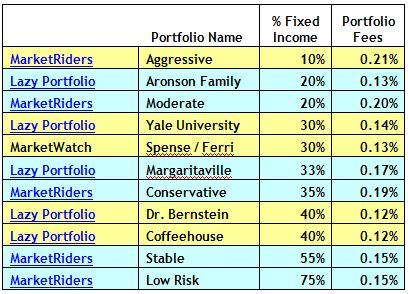Popular Posts
The famous professors at Yale have proven that asset allocation accounts for 90% of a portfolio’s return and that stock picking and market timing account for less than 10%. So what a great time to look at how different asset allocations are faring in this market!
In 2008 it turns out that asset allocation decisions have everything to do with a portfolio performance.
On MarketRiders, we use our own ETF portfolio builder to track some “Celebrity Portfolios” including the “Lazy Portfolios” (published by Paul B. Farrell at Marketwatch). These portfolios mimic allocations based upon Yale University’s David Swensen, Dr. William Bernstein, Ted Aronson, and Bill Schulthesis who wrote “The Coffeehouse Investor.” Community members also have posted many interesting portfolios with unique asset allocations that have held up well in the last few months.
These portfolios use ETFs without active management and we track weighted average portfolio fees. The component ETF fees range from .08% to .50% and the weighted average portfolio fees are between .12% and .21%.
Comparing and contrasting portfolios with similar asset allocations, shows a lot about how to build solid “all weather” allocations that have held up even in 2008. While some of the variance is surely explained by the allocation in non-equities (Bonds, Treasury Inflation Protected Bonds and Cash), a lot of it is explained by the level of diversification amongst the other asset classes.

There’s quite a variance between some of the portfolios – even when their equity exposures are similar. Two portfolios each with 60% equity exposure have dramatically different results.
For example, Bill Schulthesis, a ex-Salomon Smith Barney broker who wrote The Coffeehouse Investor, designed a portfolio with 40% in an intermediate bond index (BND) and 10% in each of 6 stock funds (Vanguad REIT ETF (VNQ), SPDR S&P 500 ETF (SPY), Vanguard Small-Cap ETF (VB), Vanguard Small-Cap Value ETF (VBR), Vanguard Value ETF (VTV), Vanguard FTSE All World ex-US ETF (VEU)). Dr. William Bernstein wrote the “Intelligent Asset Allocator” and “The Four Pillars of Investing” and proposed the same basic allocation. But high exposure to small cap value US stocks and REITs allowed Coffeehouse’s returns to trump Bernstein by over 2 times.
Here are the results as of last night’s close. These portfolios and the ETFs in them are posted on MarketRiders.
The Best and the Worst Returns
To better understand where the variances lie, we drill down into each asset class to see where returns (or lack thereof) are coming from. Aronson’s portfolio, is the worst so far, down (16.65%) with 80% equity exposure. Unfortunately, Aronson had no REIT exposure and heavy exposure to Emerging Market (VWO) and Foreign Markets (European (VGK) and Pacific (VPL)) which have both been crushed this year. Aronson’s portfolio has performed very well for 5 years on the backs of these asset classes, but 2008 has been his come-uppance.
The MarketRiders “Low Risk” portfolio is doing the best so far this year – down only (1.83%) – but with 25% exposure to equity and Real Estate (RWR). A strong US allocation (iShares S&P SmallCap 600 Index (IJR) and SPY) over Foreign Developed and Emerging Markets (VEU) helped dampen the losses.
It’s Time to Rebalance!
Today, we’re rebalancing a few of these portfolios where actual allocations now vary greater than 20% off our targets. The most out of balance portfolio is the one built by John Spense and Rick Ferri on MarketWatch. Emerging Markets, Foreign Markets, TIPs and Small Cap US stocks are all out of whack so this portfolio and others will be brought back to their targets.
Stay tuned. At the end of the year, we’ll report back and show you how these portfolios did.